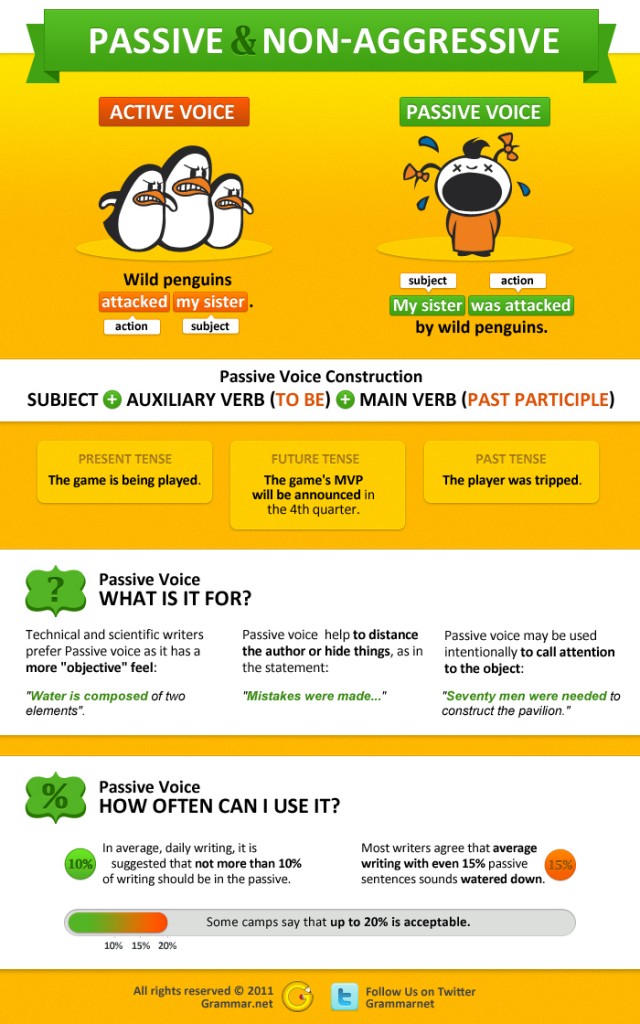In writing, sentences are considered to be of “active” or “passive” construction (“voice”) depending on where the emphasis is placed. If the emphasis is placed on the subject, the sentence is considered active, but if emphasis is placed on the object of the action, the sentence is passive.
Wikipedia’s passive voice definition states, “The passive voice is a grammatical construction (a ‘voice’) in which the subject of a sentence or clause denotes the recipient of the action (the ‘patient’) rather than the performer (the agent).”
Infographic is clickable.
To download high resolution poster click here.
Embed this image to your site:
Examples of Passive Voice
The chicken was eaten by the fox.
My sister was attacked by wild penguins.
Examples of Active Voice
The fox ate the chicken.
Wild penguins attacked my sister.
Writers generally avoid the passive because it does not have the “punch” of the active voice. “The fox ate” and “wild penguins attacked” create a more powerful statement. In addition to the watered down feeling, passive construction can also distance the author or hide things, as in the statement, “mistakes were made”.
In some cases, the passive may be used intentionally to call attention to the object. “Seventy men were needed to construct the pavilion.” This statement uses the passive to call attention to the large number of men necessary to accomplish the task.
Constructing a Passive Sentence
The auxiliary verb is frequently a form of “to be“, and the main verb must always be in past participle form.
subject + auxiliary verb (to be) + main verb (past participle)
Past tense: The player was tripped.
The reporter writing about the game may not know who tripped the player.
Present tense: The game is being played.
The reporter might not know which teams are playing or where.
Future tense: The game’s MVP will be announced in the 4th quarter.
The reporter knows an MVP will be chosen but does not know who it will be.
The Passive Voice in Action
In argumentative writing, where the author is attempting to convince an audience or get a point across, the number of passive sentences should be as low as possible, with 0% as ideal. The active voice feels more to the point, and the author seems to be taking more responsibility in what he is writing.
In average, daily writing, it is suggested that not more than 10% of writing should be in the passive. Some camps say that up to 20% is acceptable, but most writers agree that average writing with even 15% passive sentences sounds watered down.
Technical and scientific writing differs from other styles in that the passive is useful and used liberally; some writers in various fields prefer the passive, stating that it has a more “objective” feel. Examples of passive voice along a scientific vein might be, “Water is composed of two elements”, or “The degree of combustion can be measured and analyzed with test equipment”. In the first example, two elements compose water, but water is the main focus of the sentence. The second sentence is similar–test equipment measures combustion, but combustion is of greater interest.
Think of a few popular sayings and determine if they are passive or active, and then change them to the opposite voice. Is there a shift in the overall feeling of the statement when the emphasis is moved?








